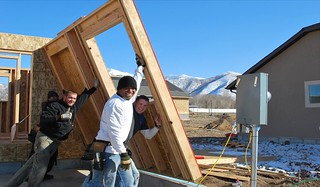Two very different views of the condition of American cities

Posted June 24, 2013 at 1:29PM
Remarkably, the past week saw the release of two major publications detailing the condition of American cities, both from respected authors but each taking a very different view of things. Let’s compare them. (Warning: this is not a short blog post; there is too much meat in these publications to address glibly.)
The glass is mostly full, and it’s exciting
First up is the eagerly awaited The Metropolitan Revolution: How Cities and Metros Are Fixing Our Broken Politics and Fragile Economy, by the Brookings Institution’s Bruce Katz and Jennifer Bradley. (Full disclosure: I know and like Bruce, and am a huge fan of the work that he and his colleagues have been doing for well over a decade at Brookings.)
This is a very upbeat book. It argues that, in the 21st century, metropolitan regions provide the true scale of “cities,” not the archaic boundaries that separate formal jurisdictions from each other. I couldn’t agree more: we sometimes have to work with political jurisdictions to get things done, but neither economic nor environmental factors respect those boundaries. Indeed, Katz and Bradley go so far as to argue that there is no “American” economy; to the extent that a national economy exists, it is a composite of metropolitan economies.
Moreover, the authors posit, cities and metros are the true economic leaders, especially in the post-recession, still-recovering economy. They are no longer waiting for a dysfunctional federal government or inconsistent and fickle state governments to assert leadership. Indeed, much of the new energy in our economy isn’t about political institutions at all, but rather about other kinds of leadership, about networks. The result is that cities and metros are happening, and Getting Things Done:
“The real, durable reshaping is being led by networks of city and metropolitan leaders—mayors and other local elected officials, for sure, but also heads of companies, universities, medical campuses, metropolitan business associations, labor unions, civic organizations, environmental groups, cultural institutions, and philanthropies. These leaders are measuring what matters, unveiling their distinctive strengths and starting points in the real economy: manufacturing, innovation, technology, advanced services, and exports . . . They are remaking their urban and suburban places as livable, quality, affordable, sustainable communities and offering more residential, transport, and work options to firms and families alike. And they are doing all these things through coinvention and coproduction.”
Katz and Bradley cite example after example of the Creative Class – knowledge-based and new-technology workers – bringing a new era of accomplishment. The passage below, although a bit long for the usual blog post, is very worth reading to get the positive, enthusiastic tone of the book with regard to both the economy and the environment:
“With innovation the clear driver of economic growth and productivity and federal innovation funding at risk, metros like New York are making sizable commitments to attract innovative research institutions, commercialize research, and grow innovative firms. With human capital the necessary ingredient for successful firms and places, metros like Chicago are overhauling their community college systems to ensure that students are trained for quality jobs that offer good wages and benefits. With infrastructure the platform for global trade and investment and no national freight policy in place, metros like Miami and Jacksonville are modernizing their air, rail, and sea freight hubs to position themselves for an expansion in global trade.
“With companies and consumers demanding communities that are more spatially efficient and federal funding for transportation uncertain, metros like Los Angeles, Denver, and Chicago are largely self-financing the building and retrofit of their own transit systems. With global demand rising and the future of federal trade policy unclear, metros like Portland, Syracuse, and Minneapolis–St. Paul are reorienting their economic development strategies toward exports, foreign direct investment, and skilled immigration.
“With the world undergoing a systemic shift toward sustainable growth (a third industrial revolution) and federal energy and environmental policies under siege, metros like Seattle and Philadelphia are cementing their niches in energy-efficient technologies. And with immigration altering the social fabric of American society and national immigration reform seemingly impossible to achieve, metros like Houston are taking innovative steps to integrate tens of thousands of new immigrants into economic and community life.”
The theme is clear: our cities aren’t deferring to other levels of government, and they certainly aren’t waiting for the feds and some states to get over their current partisan paralysis.  Note also the references to companies and consumers demanding more spatial efficiency, and the emphasis on energy-efficient technologies. This is what Katz in Governing called “the synergy between enterprise and the ecosystem.”
Note also the references to companies and consumers demanding more spatial efficiency, and the emphasis on energy-efficient technologies. This is what Katz in Governing called “the synergy between enterprise and the ecosystem.”
I can relate to aspects of this in my own career. I began it as someone quite enamored of the potential of public policy to get things done, particularly at the federal level. Indeed, I still believe strongly in the importance of federal and state regulation to guard against excesses of business, and in government support for innovative private action. Business frequently lacks economic motivation to do the right things for the environment and for human welfare on its own.
But, if that is still frequently true, it is no longer always true. Today, in many cases business interests do align with the public interest in a clean, fair and healthy environment. Regulation, while important to prevent bad activity, has seldom been good at advancing innovation (though it has been sometimes). Today, I personally find more excitement and potential for accomplishment by working directly with the more creative parts of the private sector, on the ground in neighborhoods and metropolitan regions.
Regions, say Katz and Bradley, provide the right scale for innovation. The Metropolitan Revolution puts it succinctly:
“Cities and metros aggregate people and places in a geography that is large enough to make a difference but small enough to impart a sense of community and common purpose.”
Even in places such as Detroit and northeastern Ohio, Katz and Bradley are finding reason for optimism.
I, too, am optimistic about cities and metros, for many of the same reasons that the Brookings authors cite. I also see a resurgence in the growth of inner cities and suburbs, a slowing of suburban sprawl, and demographics that are only going to strengthen urban places. The road will be bumpy in some places, and care will have to be taken to ensure that benefits flow to all sectors of society, but all the trends are in the right direction. I confess that I haven’t yet read all of Katz and Bradley’s book – I was limited to the portions that were made available to the press in advance of formal publication – but I like what I have seen so far. A lot.
This video presents the gist in 46 succinct seconds:
The glass is draining quickly, and it’s worrisome
One gets a far less robust picture of the condition of American cities from State of the City: 5 Trends Impacting America’s Cities, released on Monday by Living Cities, a consortium of philanthropic institutions working “to improve the lives of low-income people and the cities where they live.”
Here are the five trends detailed in the report:
- Fiscal strain is causing city governments to reduce services and scale back capital investment.
- Failing infrastructure is inhibiting economic growth, sustainability and overall mobility of goods, people, and information.
- Stagnant educational outcomes have implications for talent production, attraction and matching to jobs.
- The changing economic landscape is creating unemployment and shifting centers of job creation.
- The collapse of the housing market and the tightening of the rental market are creating material pressure on household economics and the health of communities.
In other words, where Katz and Bradley see excitement, innovation, leadership, and economic recovery, Living Cities sees declining city services, crumbling infrastructure, a failing educational system, unemployment, and struggling households.
The purposes of the two reports are quite different, explaining part of the differences in tone. The Brookings Metropolitan Center, which Katz heads, has for years been stressing that we now live in a metropolitan world, not an “urban” one, and The Metropolitan Revolution is designed, in part, to strengthen that case.  Living Cities, by contrast, is focused on poverty, and only incidentally on the larger economy. And, as a philanthropic collective, it may be stressing (more by implication than direct language) where philanthropy might spend its resources to produce the greatest results from limited resources. If The Metropolitan Revolution emphasizes the creative class and innovation, State of the City emphasizes the plight of those left behind by the creative class and innovation:
Living Cities, by contrast, is focused on poverty, and only incidentally on the larger economy. And, as a philanthropic collective, it may be stressing (more by implication than direct language) where philanthropy might spend its resources to produce the greatest results from limited resources. If The Metropolitan Revolution emphasizes the creative class and innovation, State of the City emphasizes the plight of those left behind by the creative class and innovation:
“Many books and organizations have emerged touting the key role of cities in building tolerance among people, spurring economic growth nationally, and accelerating new ideas that improve how we live. The level of attention being paid towards American cities is long overdue, but noticeably absent from these conversations is the fact that low-income people face tremendous hurdles to accessing the opportunities that cities create.”
Among the more specific details cited by Living Cities are these:
- City budgets are strained particularly by rising health care and pension costs, and rising costs for maintenance and repair of water, electric, sewer, and transportation infrastructure.
- Our educational system is broken, its dysfunction compounded by a changing workplace whose skill needs are evolving too rapidly for schools to catch up (“the skills we’re teaching people are not necessarily the skills the global workforce demands. This skills/job mismatch trend, therefore, must be considered an extension of the education trend. We can no longer rely on the outdated education and worker training systems that no longer consistently lead to employment opportunities”).
- At the same time as lower-income citizens struggle to afford for-sale housing, there is an undersupply of rental properties, ”as multifamily home production is at its lowest in 17 years.”
The report is surely correct in observing the near-tautology that economic hardships fall disproportionately on lower-income Americans. For the most part, it does not address environmental issues, but it does discuss inefficiencies in public transit service. And Living Cities doesn’t shy away from controversy, attacking rail transit investments as siphoning resources away from buses, for example, and asserting that “low-income transit riders tend to live further from the urban core, resulting in less access to transportation.”
As an advocate of both bus and rail transit, I don’t share the implication of the first assertion that the two are inexorably in competition for the same dollars; in fact, some research suggests that the two have synergistic rather than competitive impacts, with cities with the most rail service also having the most bus service. As to the latter, lower-income transit riders in the far suburbs do face ridiculously bad service in many cases. But it would come as a surprise to many low-income residents of inner cities that most low-income transit riders are in the far suburbs.  (Maybe the author meant to say that most transit riders in far suburbs are low-income; that is undoubtedly true, if a very different statement.)
(Maybe the author meant to say that most transit riders in far suburbs are low-income; that is undoubtedly true, if a very different statement.)
In and around Washington, DC where I live, for example, lower-income residents tend to live on the east side of the inner city and in the eastern inner suburbs, while higher-income residents live to the west, both within the city and in the far suburbs; it’s not about who lives closest to the core. These quibbles aside, I certainly don’t dispute that our nation’s dispersed land use patterns and limited public transit systems create gross inefficiencies in travel time, distance and convenience for transit-dependent Americans.
The report observes that many of the challenges faced by cites and their lower-income residents are due to or profoundly influenced by large social and economic forces, and are so fundamental that new, more systemic approaches are needed to achieve reform. Indeed, Living Cities has some sharp words for the place-based world of community development, which it seems to view as largely obsolete in today’s world. These is from the report’s lead paragraphs:
“In the decades following World War II, the challenges the urban poor have faced in the U.S. have primarily been blamed on geographic isolation in blighted neighborhoods. Conventional wisdom had it that if leaders improved such neighborhoods — by upgrading buildings, attracting employers, and delivering programs to strengthen the social fabric — residents’ opportunities and incomes would improve as well . . .
“However, the world has drastically changed over the past few decades. Jobs that once flourished in downtown factories and offices have moved beyond city limits to the suburbs and abroad; technology has changed how people interact and what defines community; and poverty is no longer concentrated solely in the urban core, with failing schools, foreclosed homes, and high unemployment rates plaguing all communities.
“Despite this reality, the community development sector has failed to keep up with these enormous changes. . . . Place-based efforts, while beneficial to some, are not sufficient to reaching the scale necessary to fix these broken systems.”
I know from personal conversations that this point of view is not limited to Living Cities. I’ve heard it from at least two other large philanthropic institutions.
The report is less clear on what new remedies should be addressed to these new realities, though at the end of the discussion of each trend it includes brief mentions of “emerging responses” that, if not sweeping, are innovative.
The glass is murky, but maybe brighter than in the recent past?
I have really struggled with how to comment on these disparate views of cities. There is truth in both views, I think, but where does that leave us?
 I’ll start by saying that I’m not sure the shot at place-based community development is entirely fair, even though I’ll concede that it seems to be gaining currency in the philanthropic field. While I couldn’t agree more that we require systemic change to address chronic poverty (and, for that matter, a deteriorating environment), and that the geography of socio-economic challenges is changing, in my opinion we continue to need place-based efforts as well. Indeed, it’s possible to simultaneously address places and systems, for example, through an instrument of change such as LEED for Neighborhood Development, which provides aspirational but achievable standards for better development in particular places; LEED-ND at its core is a system designed to affect positive change, but it operates in particular places. Some are using the system in its traditional (and somewhat complicated) role of certifying new development, but its greater power may lie in more creative applications, as model standards for municipalities and as an informal planning framework for distressed neighborhoods.
I’ll start by saying that I’m not sure the shot at place-based community development is entirely fair, even though I’ll concede that it seems to be gaining currency in the philanthropic field. While I couldn’t agree more that we require systemic change to address chronic poverty (and, for that matter, a deteriorating environment), and that the geography of socio-economic challenges is changing, in my opinion we continue to need place-based efforts as well. Indeed, it’s possible to simultaneously address places and systems, for example, through an instrument of change such as LEED for Neighborhood Development, which provides aspirational but achievable standards for better development in particular places; LEED-ND at its core is a system designed to affect positive change, but it operates in particular places. Some are using the system in its traditional (and somewhat complicated) role of certifying new development, but its greater power may lie in more creative applications, as model standards for municipalities and as an informal planning framework for distressed neighborhoods.
LEED-ND is now in the implementation stage, both formally and informally, and it is critical that it be deployed and evolved in a way that establishes models for better living conditions where poverty exists, be it in inner cities or suburbs. The establishment and spread of those models then becomes systemic change.
The same is true, by the way, for the Green Communities program of Enterprise Community Partners (disclosure: I worked on both LEED-ND and Green Communities), which sets voluntary criteria for greening affordable housing. It has proved enormously useful in providing lower-income families with healthier and more environmentally sustainable homes, but it has done so through the instrument of community development in particular places. The work that another major supporter of community development, the Local Initiatives Support Corporation, has done with NRDC to reconceive low-income neighborhoods around principles of green development is enormously exciting. Yes, we’ve worked in particular places, but the idea is to establish models that can be applied more broadly. Neither LEED-ND nor Green Communities is mentioned in the report, even as “emerging trends.”
 Does place-based community development need to add more geographically diverse approaches, and more holistic approaches that go beyond bricks and mortar? (On the latter point, the report cites with approval HUD’s Choice Neighborhoods program, which addresses the needs of communities with multi-faceted approaches.) Absolutely, and kudos to Living Cities for saying so. But let’s don’t write off the model. Personally, I see a lot of positive energy in the field right now; I don’t see it as obsolete or lacking approaches that can achieve scale.
Does place-based community development need to add more geographically diverse approaches, and more holistic approaches that go beyond bricks and mortar? (On the latter point, the report cites with approval HUD’s Choice Neighborhoods program, which addresses the needs of communities with multi-faceted approaches.) Absolutely, and kudos to Living Cities for saying so. But let’s don’t write off the model. Personally, I see a lot of positive energy in the field right now; I don’t see it as obsolete or lacking approaches that can achieve scale.
I also think there are risks as well as potential benefits in newer, more systemic approaches. I’ve been through enough funding cycles and strategic planning exercises to know how seductive broad, systemic reform appears, promising more “bang for the buck” from limited resources. And the strategy can deliver, at least in theory, when it works and works quickly.
But sometimes putting one’s eggs in the basket marked “systemic reform” can come at a price. The environmental community was delivered a lesson in political reality as a result of our devoting a large portion of our resources to a decades-long effort to secure systemic federal climate legislation that, for reasons beyond our control, ultimately proved unsuccessful. That was followed by huge philanthropic and environmental-community investment in hoped-for systemic reform of federal transportation law. That, too, produced less than optimum results. In the end, both of those efforts, which appeared promising when initiated, carried opportunity costs. (Both outcomes also strongly support Katz and Bradley’s central thesis that the federal government is too broken to be available any time soon as an instrument of change; philanthropies and NGOs alike are now struggling with what the right non-federal approaches are.)
It has been said that life is what happens while we’re making big plans. So we had better pay some attention to the here and now, too. Frequently, the best opportunities for change are going to come in places where the right ingredients are aligning for added value to make a difference. While we may not be able to afford to be anything less than strategic in choosing the right locations, we also may not be able to afford lengthy periods of concentrating on systemic efforts that don’t pan out while largely neglecting the local level.
 Moreover, I would argue that innovation is inherently local in nature. Katz and Bradley make a very interesting point to the effect that the strengths and innovations that can emerge in Pittsburgh will likely be very different than those that emerge in, say, San Diego. How can groups like the one I work for – and indeed, Brookings, and the partners in Living Cities, too – harness that innovation to the right social and environmental ends? In a lot of cases, it will be because of ingredients that first exist in a particular place and time, and then spread from there.
Moreover, I would argue that innovation is inherently local in nature. Katz and Bradley make a very interesting point to the effect that the strengths and innovations that can emerge in Pittsburgh will likely be very different than those that emerge in, say, San Diego. How can groups like the one I work for – and indeed, Brookings, and the partners in Living Cities, too – harness that innovation to the right social and environmental ends? In a lot of cases, it will be because of ingredients that first exist in a particular place and time, and then spread from there.
All that said, it’s hard to disagree with the well-documented problems cited by Living Cities in its report. Anyone unaware that the US public educational system is horribly broken, for example, simply hasn’t been paying attention. Although I am paid to advocate for the environment first, I’m not sure there is a more important problem for either innovation or philanthropy to help solve. (Heck, I believe that inferior city education is an environmental problem.) Too many of our disadvantaged kids are losing ground compared to affluent kids, and nearly all of our kids are losing ground compared to those in other countries.
I don’t disagree with other big trends, either – diminishing municipal capacity, aging infrastructure, unemployment, household strain – but those problems are so daunting that I’m not sure they are soluble by an exclusively big-picture approach. I keep coming back to experimentation, innovation, and the propagation of models that are locally developed.
When you come down to it, the folks at Brookings know a lot more about the new metropolitan economy than I do (though I know more than a little), and the folks at Living Cities know much more about poverty and community development than I do (though, again, I know more than a little). Who is right? Should we be optimistic about the future of cities, or pessimistic? I’m notorious for being the latter – I’m always convinced my favorite sports teams will lose – but, when it comes to cities, I’m more with Brookings.
I believe the state of cities (or, if you prefer, the future of metros) has never looked brighter in my lifetime. Yes, the inequality created by wealth distribution in our country is appalling; so is our educational performance; and many people are still hurting from the recession.
But, if you think cities are hurting now, you should have seen them 20 or 40 years ago, when whole districts were being burned to the ground and people of means were fleeing as fast as they could, taking their tax dollars and businesses with them. Crime was so rampant and scary in inner cities that smug suburbanites would have friendly debates about whose inner city was the real “murder capital” of the country.
By comparison, it’s amazing how much positive energy there is in cities (and, to be sure, in metro areas) today. Suburban sprawl has been slowed considerably. Inner cities are growing again. People of means, especially young people, want to be in cities today. While that carries its own set of challenges, I would submit that addressing the challenges of gentrification is a far better problem to have than coping with massive abandonment and rampant crime. It’s telling, by the way, that crime is not mentioned even once in State of the Cities: 20 years ago the report would have been considered hopelessly naïve without discussing it. There is a lot of good news about cities, but you’ll have to read the Brookings book to learn much about it.
On what do the authors agree?
A significant point on which both The Metropolitan Revolution and State of the City agree is that there is no longer a bright-line demarcation between “cities” and “suburbs.” But that’s because if suburbs – especially inner suburbs – are now dealing with problems once thought to be located only in inner cities, our inner cities are now enjoying a resurgence of social and economic activity once thought to be the hallmark of suburbs. To me, there’s more good news than bad in the new paradigm.
Which is certainly not to say that we can afford to ignore the very real negative trends that threaten our most vulnerable citizens. To the contrary, we should find ways to harness the positive energy in cities and metros to address the problems afflicting those left behind by progress.
My guess is that the Brookings authors and Living Cities authors wouldn’t disagree much on the underlying facts. They just each believe they have a story that needs telling. If their two stories have very different points of emphasis, they are both worth knowing.
Related posts:
- A low-income community taps homegrown leadership for a brighter future (October 17, 2012)
- Can collaboration substitute for authority in solving regional problems? (May 1, 2012)
- What does the new economy mean for the shape of communities? (February 6, 2012)
- The geography of persistent unemployment contains some surprises (February 1, 2012)
- The new economy: work closer, live smaller, connect better (December 30, 2011)
- The economic importance of metro regions (July 25, 2011)
- Study identifies 15 US metro regions as leaders in transportation innovation & performance (February 25, 2011)
- "Cities" may not matter as much as we think - regions and neighborhoods are where things actually happen (November 1, 2010)
- US cities fare poorly in international “quality of life” rankings (April 30, 2009)
- Bringing regions together for cooperation and planning would promote sustainability (March 6, 2009)
Move your cursor over the images for credit information.

